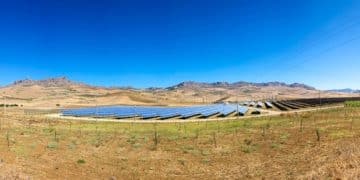Updated US Energy Star Appliance Standards: What You Need to Know for 2025

The updated US Energy Star appliance standards, effective January 2025, aim to enhance energy efficiency and reduce carbon emissions by setting stricter criteria for appliance certification, influencing manufacturing and consumer choices towards more sustainable options.
Navigating the landscape of energy-efficient appliances is becoming increasingly crucial, especially with the updated US Energy Star appliance standards set to take effect in January 2025. These changes promise to reshape how we think about and choose our household appliances.
Understanding the Energy Star Program
The Energy Star program, a joint initiative of the US Environmental Protection Agency (EPA) and the Department of Energy (DOE), is designed to help consumers identify and purchase energy-efficient products. Before diving into the 2025 updates, let’s understand the history and core principles of this program.
The History and Evolution of Energy Star
Launched in 1992, the Energy Star program initially focused on computer equipment but quickly expanded to cover a wide range of appliances, lighting, and building products. Its aim has always been to reduce energy consumption and greenhouse gas emissions by promoting the use of more efficient technologies.
Core Principles and Goals
The program operates on several key principles, including setting performance benchmarks for energy efficiency, providing clear and reliable information to consumers, and fostering innovation among manufacturers. By meeting Energy Star criteria, products demonstrate superior energy performance compared to standard options.
- Reducing energy consumption nationwide.
- Lowering greenhouse gas emissions.
- Helping consumers save money on utility bills.
- Driving innovation in energy-efficient technologies.
The Energy Star program continues to evolve, regularly updating its standards to reflect technological advancements and emerging energy challenges. The upcoming changes in 2025 are a testament to the program’s ongoing commitment to these goals.
Key Changes in the 2025 Energy Star Standards
The 2025 updates to the Energy Star appliance standards bring significant changes to the efficiency criteria that manufacturers must meet. These changes aim to push the envelope further in energy conservation.
Stricter Efficiency Requirements
One of the primary changes is the tightening of energy efficiency requirements across several appliance categories. This means that appliances must now perform even better to earn the Energy Star label.
Impact on Manufacturers
Manufacturers will need to redesign and re-engineer their products to comply with these new standards. This could involve using more efficient components, improving insulation, or adopting advanced control systems.

- Adoption of high-efficiency compressors.
- Improved insulation materials and techniques.
- Advanced control systems for optimized performance.
- Innovative designs to minimize energy waste.
The updated requirements will particularly affect appliances such as refrigerators, washing machines, and dishwashers, where energy consumption has a substantial impact on overall household energy use.
Which Appliances Are Affected?
The 2025 Energy Star standards will impact a wide range of household appliances. Knowing which appliances are affected helps you make informed purchasing decisions.
Refrigerators and Freezers
Refrigerators and freezers are among the most energy-intensive appliances in many homes. The new standards require significant reductions in energy consumption for these appliances.
Washing Machines and Dryers
Washing machines and dryers are also targeted by the new standards. Efficiency improvements in these appliances can lead to substantial energy and water savings.
Dishwashers
Dishwashers must now meet stricter criteria for water and energy use per cycle. These improvements aim to reduce the overall environmental impact of dishwashing.
- Improved water filtration systems.
- More efficient heating elements.
- Optimized spray arm designs.
- Smart sensors to minimize water usage.
Other appliances that may be affected include air conditioners, water heaters, and lighting products. Always check for the Energy Star label to ensure you’re purchasing the most energy-efficient options available.
Benefits of Upgrading to Energy Star Appliances
Upgrading to Energy Star certified appliances offers numerous benefits, from cost savings to environmental protection. Here is a detail about the advantages.
Reduced Energy Bills
One of the most immediate benefits of using Energy Star appliances is lower energy bills. These appliances use less energy to perform the same tasks compared to standard models.
Environmental Impact
By reducing energy consumption, Energy Star appliances help lower greenhouse gas emissions and decrease your carbon footprint. This contributes to a more sustainable environment.

- Lower carbon emissions.
- Reduced water usage (for appliances like washing machines and dishwashers).
- Less strain on the power grid.
- Support for renewable energy sources.
Energy Star appliances also often qualify for rebates and incentives from local utilities and government programs, making them an even more attractive investment.
How to Identify Energy Star Appliances
Identifying Energy Star appliances is straightforward thanks to the program’s recognizable label. Understanding how to spot this label helps you make informed purchasing decisions.
The Energy Star Label
The Energy Star label is a blue and white symbol that indicates a product meets the program’s energy efficiency criteria. Look for this label when shopping for new appliances.
Online Resources
The Energy Star website provides a wealth of information, including a product finder tool that allows you to search for certified appliances by type and brand. The website also has some tips and information about energy conservation!
Checking Energy Performance
Beyond the label, it’s essential to check the energy performance ratings of appliances. This information is usually available on the product’s EnergyGuide label.
The EnergyGuide label provides an estimate of the appliance’s annual energy consumption and operating costs, allowing you to compare different models and choose the most efficient option. Also, you can use sites like the EPA to learn the energy ratings.
Preparing for the 2025 Transition
As the 2025 Energy Star standards approach, there are steps you can take to prepare and make the most of these changes. Here is a guide to get ready for it.
Assessing Current Appliance Efficiency
Start by evaluating the energy efficiency of your current appliances. Identify older models that consume more energy and may be due for replacement.
Planning Future Upgrades
Develop a plan for upgrading to Energy Star certified appliances as your existing models reach the end of their lifespan. Consider the long-term cost savings and environmental benefits.
Budgeting and Financing
Factor in the cost of new appliances into your budget. Explore financing options, rebates, and incentives that can help offset the upfront investment.
- Utility rebates.
- Federal tax credits.
- State and local incentives.
- Financing programs for energy-efficient upgrades.
By taking these steps, you can ensure a smooth transition to more energy-efficient appliances and enjoy the long-term benefits of reduced energy consumption and lower utility bills.
| Key Point | Brief Description |
|---|---|
| ⭐ New Standards | Appliances must meet stricter efficiency criteria. |
| 💰 Energy Savings | Lower utility bills and environmental impact. |
| ✅ Check the Label | Look for the Energy Star label on appliances. |
| 💡 Plan Upgrades | Assess and plan upgrades to efficient appliances. |
FAQ
▼
The Energy Star is a U.S. government-backed symbol for energy efficiency, providing consumers an easier way to identify products and services that save energy, money, and protect the environment.
▼
The updated US Energy Star appliance standards will be effective starting in January 2025. Keep an eye out on this date to make smarter decisions!
▼
Refrigerators, washing machines, and dishwashers are among the appliances most affected by the new standards, requiring significant improvements in energy efficiency.
▼
Look for the blue and white Energy Star label on the appliance. Check the Energy Star website for a list of certified products and detailed energy performance ratings.
▼
Yes, many local utilities and government programs offer rebates and incentives for purchasing Energy Star certified appliances, helping to offset the upfront costs.
Conclusion
As we approach the implementation of the updated US Energy Star appliance standards in January 2025, it’s crucial to understand the changes and their implications. By preparing for this transition and embracing energy-efficient appliances, we can collectively reduce energy consumption, lower utility bills, and contribute to a more sustainable future.





